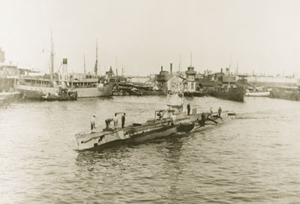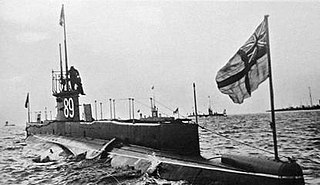
HMS E3 was the third E-class submarine to be constructed, built at Barrow by Vickers in 1911–1912. Built with compartmentalisation and endurance not previously achievable, these were the best submarines in the Royal Navy at the start of the First World War. She was sunk in the first ever successful attack on one submarine by another, when she was torpedoed on 18 October 1914 by U-27 north of Schiermonnikoog, the Netherlands.

HMS E2 was a British E class submarine built by Chatham Dockyard. E2 was laid down on 14 February 1911 and launched on 23 November 1912.

HMS E19 was an E-class submarine of the Royal Navy, commissioned in 1914 at Vickers, Barrow-in-Furness. During World War I she was part of the British submarine flotilla in the Baltic.

HMS E7 was a British E class submarine built at Chatham Dockyard. She was laid down on 30 March 1912 and was commissioned on 16 March 1914. She cost £105,700.

HMS E9 was a British E class submarine built by Vickers, Barrow. She was laid down on 1 June 1912 and was commissioned on 18 June 1914.
HMS E10 was a British E class submarine built by Vickers, Barrow-in-Furness. She was laid down on 10 July 1912 and was commissioned on 10 March 1914. She costed £105,700. E10 was lost in the North Sea on or around 18 January 1915.

HMS E17 was a British E-class submarine built by Vickers, Barrow-in-Furness. She was laid down on 29 July 1914, launched on 16 January 1915 and was commissioned on 7 April 1915. HMS E17 was wrecked off Texel in the North Sea on 6 January 1916. Her crew were rescued by a Dutch cruiser Noordbrabant. They were interned. The conning tower of E17 is preserved as a monument at the Royal Navy Submarine Museum in Gosport, the United Kingdom.

HMS E20 was a British E-class submarine built by Vickers, Barrow-in-Furness. She was laid down on 25 November 1914 and was commissioned on 30 August 1915. She was sunk, torpedoed by UB-14, on 6 November 1915.
HMS E21 was a British E class submarine built by Vickers, Barrow-in-Furness. She was launched on 24 July 1915 and commissioned on 1 October 1915. E21 was sold on 14 December 1921.
HMS E22 was a British E-class submarine built by Vickers, Barrow-in-Furness. She was laid down on 27 August 1914 and was commissioned on 8 November 1915.
HMS E53 was a British E-class submarine built by William Beardmore and Company, Dalmuir. She was launched in 1916 and was commissioned in March 1916. E53 was sold for scrap on 6 September 1922.
HMS E29 was a British E-class submarine built by Armstrong Whitworth, Newcastle-Upon-Tyne. She was launched on 1 June 1915 and commissioned in October 1915. E29 suffered an explosion in the battery compartment which killed four men on 9 January 1916. E29 was sold on 21 February 1922.

HMS E34 was a British E-class submarine built by John Thornycroft, Woolston, Hampshire. She was launched on 27 January 1917 and commissioned in March 1917. HMS E34 sank the U-boat UB-16 off Harwich in the North Sea on 10 May 1918. E34 was mined near the Eijerlandse Gronden, the sands between the Frisian islands Texel and Vlieland on 20 July 1918. There were no survivors.
HMS E35 was a British E-class submarine built by John Brown, Clydebank. She was launched on 20 May 1916 and commissioned on 14 July 1917. E35 sank U-154 off the island of Madeira on 11 May 1918. This sinking was helped by British intelligence who had learned of a planned rendezvous between two U-boats off Cape St Vincent. E35 was sold in Newcastle on 6 September 1922.
HMS E36 was an E-class submarine built by John Brown, Clydebank for the Royal Navy. She was laid down on 7 January 1915 and was commissioned on 16 November 1916.
HMS E39 was a British E-class submarine launched by Palmers, Jarrow in 1916 and was completed by Armstrong Whitworth, Newcastle upon Tyne. She was launched on 18 May 1916 and was commissioned in October 1916.

HMS E40 was a British E-class submarine launched by Palmer, Jarrow in 1916 and was completed by Armstrong Whitworth, Newcastle upon Tyne. She was launched on 9 November 1916 and was commissioned in May 1917.

HMS E43 was a British E-class submarine built by Swan Hunter, Wallsend. She was laid down on 22 December 1914 and was commissioned on 20 February 1916. On 19 January 1917 E43 collided with E36 off Harwich in the North Sea; E36 sank with all hands. E43 was sold on 3 January 1921 but became stranded under tow west off St Agnes Head, Cornwall on 25 November 1921.
HMS E44 was a British E-class submarine built by Swan Hunter, Wallsend. She was laid down on 8 January 1916 and was commissioned on 18 July 1916. E44 was sold for scrap in South Wales on 13 October 1921.
HMS E45 was a British E-class submarine built by Cammell Laird, Birkenhead. She was launched on 25 January 1916 and was commissioned in August 1916. E45 torpedoed U-boat UC-62 in the North Sea on 15 October 1917. E45 was sold in South Wales on 6 September 1922.









